Top 10
A New Human Relative
By DANIEL WEISS
Monday, December 07, 2015
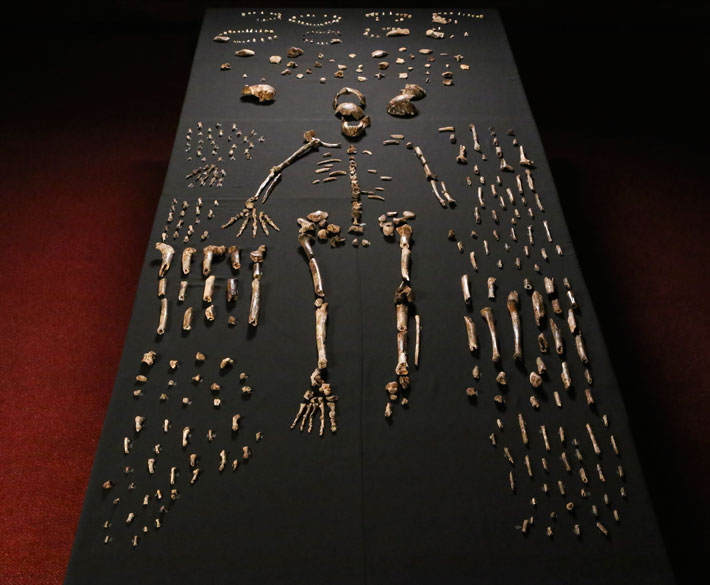 Scientists have long searched for the transitional species between apelike australopithecines, such as Lucy (Australopithecus afarensis), and early humans, such as Homo habilis. And now, deep in the Rising Star cave system in South Africa, they may have unearthed it.
Scientists have long searched for the transitional species between apelike australopithecines, such as Lucy (Australopithecus afarensis), and early humans, such as Homo habilis. And now, deep in the Rising Star cave system in South Africa, they may have unearthed it.
When amateur cavers told Lee Berger, a paleoanthropologist at the University of the Witwatersrand in Johannesburg, that they had located hominin remains in the nearby cave system, he knew he could not make it in to retrieve them himself. The passageway was extremely narrow, just seven inches wide at one point. So Berger put out a call on Facebook for diminutive, non-claustrophobic scientists and recruited a team of six women who fit the criteria.
Marina Elliott, an archaeologist from Simon Fraser University in Canada, was the first to enter the chamber. “I was stunned,” she says. “I shone my headlight around and picked up flashes of bone all over the place.” Elliott and her colleagues retrieved more than 1,500 specimens, from at least fifteen different individuals. A larger team of scientists, led by Berger, determined that the remains belong to a previously unknown species, which they named Homo naledi after its resting place—naledi means “star” in the local Sesotho language.
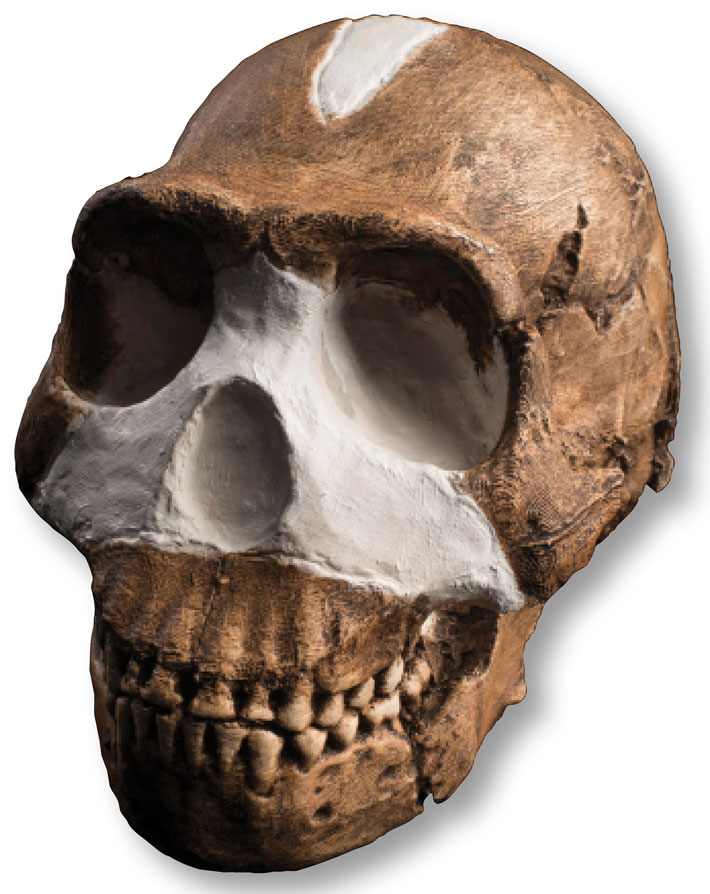 The newly discovered species had a novel mix of primitive and modern features. Its head was tiny, with a brain the size of an orange, but its skull was humanlike in shape. Its hands were adapted for manipulating objects and its feet for walking upright, but its shoulders and fingers were built for climbing. “We never expected to see a combination of characteristics like this,” says John Hawks, a paleoanthropologist at the University of Wisconsin–Madison, “but they’re all in Homo naledi, and that’s surprising.”
The newly discovered species had a novel mix of primitive and modern features. Its head was tiny, with a brain the size of an orange, but its skull was humanlike in shape. Its hands were adapted for manipulating objects and its feet for walking upright, but its shoulders and fingers were built for climbing. “We never expected to see a combination of characteristics like this,” says John Hawks, a paleoanthropologist at the University of Wisconsin–Madison, “but they’re all in Homo naledi, and that’s surprising.”
The researchers suspect Homo naledi may be among the earliest members of the genus Homo, which would mean it most likely existed around 2.5 million years ago. However, they have so far been unable to date the remains.
Earliest Stone Tools
By ZACH ZORICH
Monday, December 07, 2015
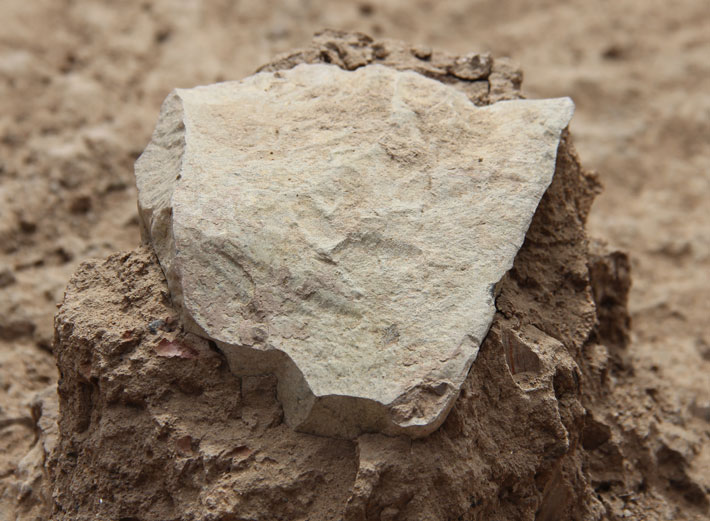 Stone toolmaking has been considered one of the defining characteristics of members of the genus Homo, but this year it was announced that newly discovered tools predate the first known humans. A research team led by Sonia Harmand and Jason Lewis of the Turkana Basin Institute at Stony Brook University found the tools at a site called Lomekwi 3 in Kenya. They are believed to be 3.3 million years old, predating Homo habilis—the first known member of the genus Homo—by about 700,000 years. A group of fossils roughly contemporaneous with the tools was discovered nearby in 1999 and dubbed Kenyanthropus platyops, a small-brained hominin that seemed unlikely to have used tools—until now. Harmand believes that stones were just one part of the early hominin toolkit and says, “Why not think that our ancestors from the beginning were using many, many tools?”
Stone toolmaking has been considered one of the defining characteristics of members of the genus Homo, but this year it was announced that newly discovered tools predate the first known humans. A research team led by Sonia Harmand and Jason Lewis of the Turkana Basin Institute at Stony Brook University found the tools at a site called Lomekwi 3 in Kenya. They are believed to be 3.3 million years old, predating Homo habilis—the first known member of the genus Homo—by about 700,000 years. A group of fossils roughly contemporaneous with the tools was discovered nearby in 1999 and dubbed Kenyanthropus platyops, a small-brained hominin that seemed unlikely to have used tools—until now. Harmand believes that stones were just one part of the early hominin toolkit and says, “Why not think that our ancestors from the beginning were using many, many tools?”
Bronze Age Bride
By DANIEL WEISS
Monday, December 07, 2015
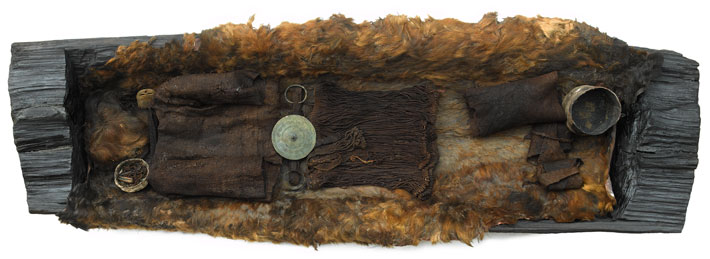
In 1921, the well-preserved remains of a young woman who died around 1370 B.C. were discovered in an elite burial near the town of Egtved, Denmark. For almost a century, she was thought to have been a local, and became known as the “Egtved Girl,” but new research has amended her story and what it may say about Bronze Age marriage alliances.
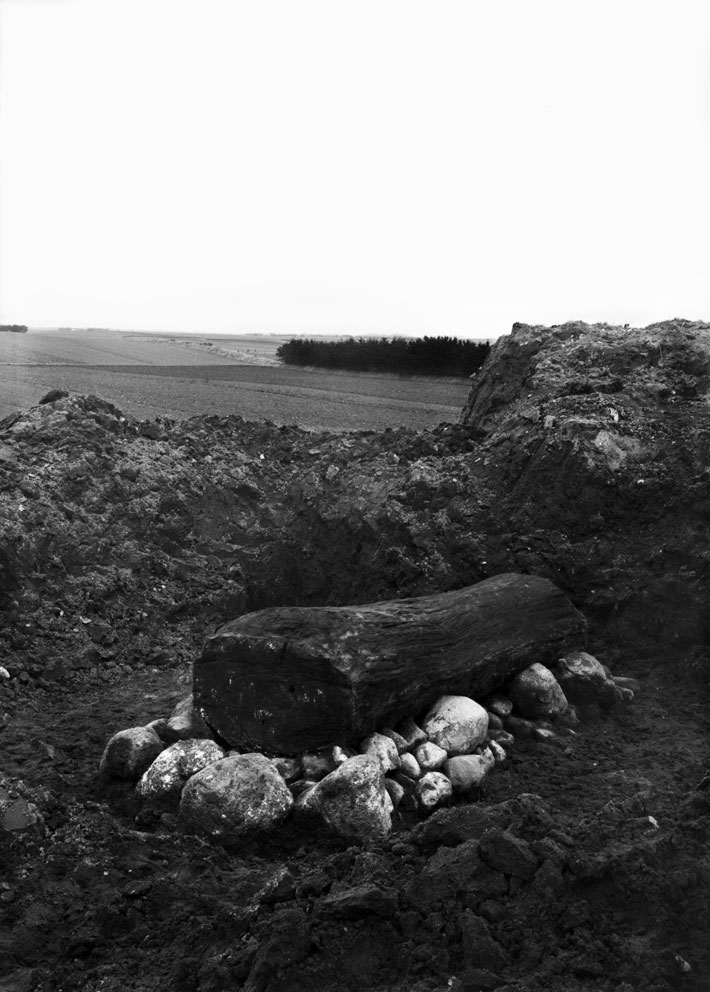 A waterlogged, acidic environment had preserved the young woman’s clothing, hair, tooth enamel, fingernails, and parts of her brain and skin. Also preserved were the cremated remains of a young child. A team led by Karin Frei of the National Museum of Denmark analyzed strontium isotopes in the young woman’s tooth enamel and found she did not grow up on the Jutland Peninsula, where Egtved is located. Instead, she was most likely raised in the Black Forest region of southern Germany, around 500 miles away. The researchers believe she was sent from her home to marry a chieftain in Jutland. Further analysis of the young woman’s fingernails and hair shows that, in the final years of her life, she appears to have moved from the Black Forest to Jutland, back to the Black Forest, then back to Jutland again shortly before her death.
A waterlogged, acidic environment had preserved the young woman’s clothing, hair, tooth enamel, fingernails, and parts of her brain and skin. Also preserved were the cremated remains of a young child. A team led by Karin Frei of the National Museum of Denmark analyzed strontium isotopes in the young woman’s tooth enamel and found she did not grow up on the Jutland Peninsula, where Egtved is located. Instead, she was most likely raised in the Black Forest region of southern Germany, around 500 miles away. The researchers believe she was sent from her home to marry a chieftain in Jutland. Further analysis of the young woman’s fingernails and hair shows that, in the final years of her life, she appears to have moved from the Black Forest to Jutland, back to the Black Forest, then back to Jutland again shortly before her death.
The remains of the child found with the young woman may help explain these travels. “Dynastic marriages were often followed by an exchange of ‘foster brothers’ to secure the alliance,” says Kristian Kristiansen of the University of Gothenburg. In such a scenario, after marrying the chieftain in Jutland, the young woman would have been sent back to the Black Forest along with a boy from Jutland, who would have been raised by her people. She would then have returned to Jutland with a young male relative, who would be raised there. The child’s cremated remains led Kristiansen to propose that the death occurred en route and the remains were buried later with the young woman when she, too, died after her return to Jutland.
The First Artists
By DANIEL WEISS
Monday, December 07, 2015
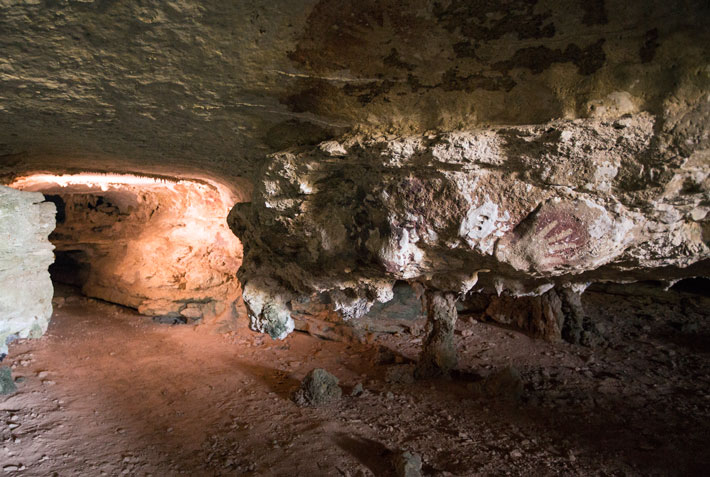
Dating cave art is notoriously difficult. But a team of researchers has taken advantage of serendipitous conditions in caves on the Indonesian island of Sulawesi to establish that images there rival any known from Western Europe in terms of age. A stencil created as the artist blew pigment around a hand is at least 39,900 years old, they report, and a painting of a piglike animal was laid down at least 35,700 years ago.
The researchers established the designs’ minimum ages by calculating the dates of deposits that had built up on top of the pigment. They had observed that, as mineral-laden water percolates through the caves’ limestone walls, calcite gradually accumulates on their surfaces. These deposits contain uranium, which decays to thorium at a known rate, so their age can be ascertained from the ratio of the two elements.
The discovery raises a new question: Did people in Southeast Asia and Western Europe develop artistic expression independently, or was it pioneered by early humans before they left Africa? “We don’t know,” says Maxime Aubert of Griffith University in Australia, “but my opinion is it probably developed a long time ago, in Africa, and then it just spread out.”
Tomb of a Highborn Celt
By JASON URBANUS
Monday, December 07, 2015
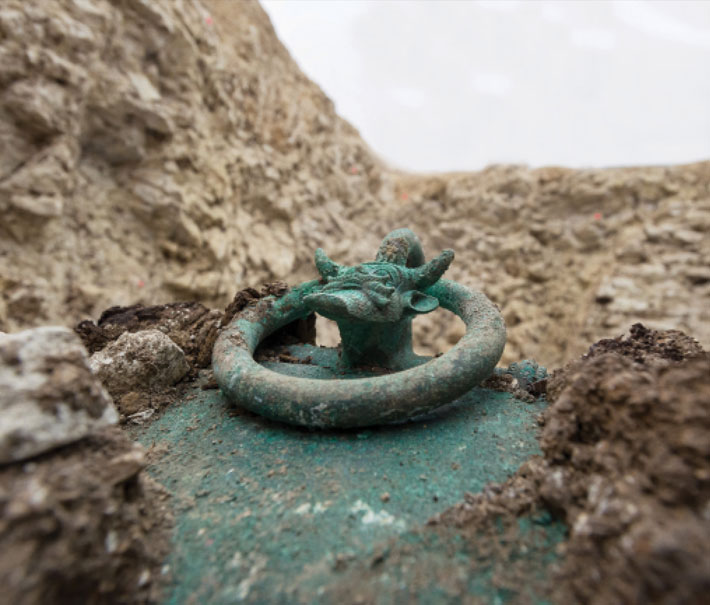 During a routine investigation of an area slated for construction in the village of Lavau in north-central France, archaeologists happened upon one of the most remarkable Iron Age discoveries of the past century. Beneath a mound measuring 130 feet in diameter, researchers from France’s National Institute of Preventive Archaeological Research were stunned to find the burial of an early Celtic “prince” dating to the fifth century B.C. They were initially unable to determine the individual’s gender, and some of the accoutrements associated with dress found near the body suggested the skeleton belonged to a woman. But testing has now confirmed with certainty that the deceased was, in fact, male.
During a routine investigation of an area slated for construction in the village of Lavau in north-central France, archaeologists happened upon one of the most remarkable Iron Age discoveries of the past century. Beneath a mound measuring 130 feet in diameter, researchers from France’s National Institute of Preventive Archaeological Research were stunned to find the burial of an early Celtic “prince” dating to the fifth century B.C. They were initially unable to determine the individual’s gender, and some of the accoutrements associated with dress found near the body suggested the skeleton belonged to a woman. But testing has now confirmed with certainty that the deceased was, in fact, male.
This wealthy Iron Age prince was buried with an assortment of luxury items, including imported Mediterranean vessels, gold jewelry, and a chariot. A finely crafted bronze wine cauldron decorated with the heads of animals and mythological creatures, and a black-figure Greek wine pitcher, indicate that the Celts in this area had robust trade and political ties with the Greeks and Etruscans—and also distinguish this as the grave of a significant person. “He had to be at the top of the local aristocracy,” says archaeologist Bastien Dubuis. “All this wealth is a reflection of the central importance of the character buried here, who exercised economic and political power in the region.”
Imported Mediterranean wine was a key commodity for the early Celts. This burial and others like it demonstrate that rituals and paraphernalia associated with the drinking and distribution of wine played a vital role in Celtic society.
Advertisement
Advertisement
IN THIS ISSUE
Advertisement

Recent Issues
-
 May/June 2024
May/June 2024
-
 March/April 2024
March/April 2024
-
 January/February 2024
January/February 2024
-
 November/December 2023
November/December 2023
-
 September/October 2023
September/October 2023
-
 July/August 2023
July/August 2023
-
 May/June 2023
May/June 2023
-
 March/April 2023
March/April 2023
-
 January/February 2023
January/February 2023
-
 November/December 2022
November/December 2022
-
 September/October 2022
September/October 2022
-
 July/August 2022
July/August 2022
-
 May/June 2022
May/June 2022
-
 March/April 2022
March/April 2022
-
 January/February 2022
January/February 2022
-
 November/December 2021
November/December 2021
-
 September/October 2021
September/October 2021
-
 July/August 2021
July/August 2021
-
 May/June 2021
May/June 2021
-
 March/April 2021
March/April 2021
-
 January/February 2021
January/February 2021
-
 November/December 2020
November/December 2020
-
 September/October 2020
September/October 2020
-
 July/August 2020
July/August 2020
-
 May/June 2020
May/June 2020
-
 March/April 2020
March/April 2020
-
 January/February 2020
January/February 2020
-
 November/December 2019
November/December 2019
-
 September/October 2019
September/October 2019
-
 July/August 2019
July/August 2019
-
 May/June 2019
May/June 2019
-
 March/April 2019
March/April 2019
-
 January/February 2019
January/February 2019
-
 November/December 2018
November/December 2018
-
 September/October 2018
September/October 2018
-
 July/August 2018
July/August 2018
-
 May/June 2018
May/June 2018
-
 March/April 2018
March/April 2018
-
 January/February 2018
January/February 2018
-
 November/December 2017
November/December 2017
-
 September/October 2017
September/October 2017
-
 July/August 2017
July/August 2017
-
 May/June 2017
May/June 2017
-
 March/April 2017
March/April 2017
-
 January/February 2017
January/February 2017
-
 November/December 2016
November/December 2016
-
 September/October 2016
September/October 2016
-
 July/August 2016
July/August 2016
-
 May/June 2016
May/June 2016
-
 March/April 2016
March/April 2016
-
 January/February 2016
January/February 2016
-
 November/December 2015
November/December 2015
-
 September/October 2015
September/October 2015
-
 July/August 2015
July/August 2015
-
 May/June 2015
May/June 2015
-
 March/April 2015
March/April 2015
-
 January/February 2015
January/February 2015
-
 November/December 2014
November/December 2014
-
 September/October 2014
September/October 2014
-
 July/August 2014
July/August 2014
-
 May/June 2014
May/June 2014
-
 March/April 2014
March/April 2014
-
 January/February 2014
January/February 2014
-
 November/December 2013
November/December 2013
-
 September/October 2013
September/October 2013
-
 July/August 2013
July/August 2013
-
 May/June 2013
May/June 2013
-
 March/April 2013
March/April 2013
-
 January/February 2013
January/February 2013
-
 November/December 2012
November/December 2012
-
 September/October 2012
September/October 2012
-
 July/August 2012
July/August 2012
-
 May/June 2012
May/June 2012
-
 March/April 2012
March/April 2012
-
 January/February 2012
January/February 2012
-
 November/December 2011
November/December 2011
-
 September/October 2011
September/October 2011
-
 July/August 2011
July/August 2011
-
 May/June 2011
May/June 2011
-
 March/April 2011
March/April 2011
-
 January/February 2011
January/February 2011
Advertisement






